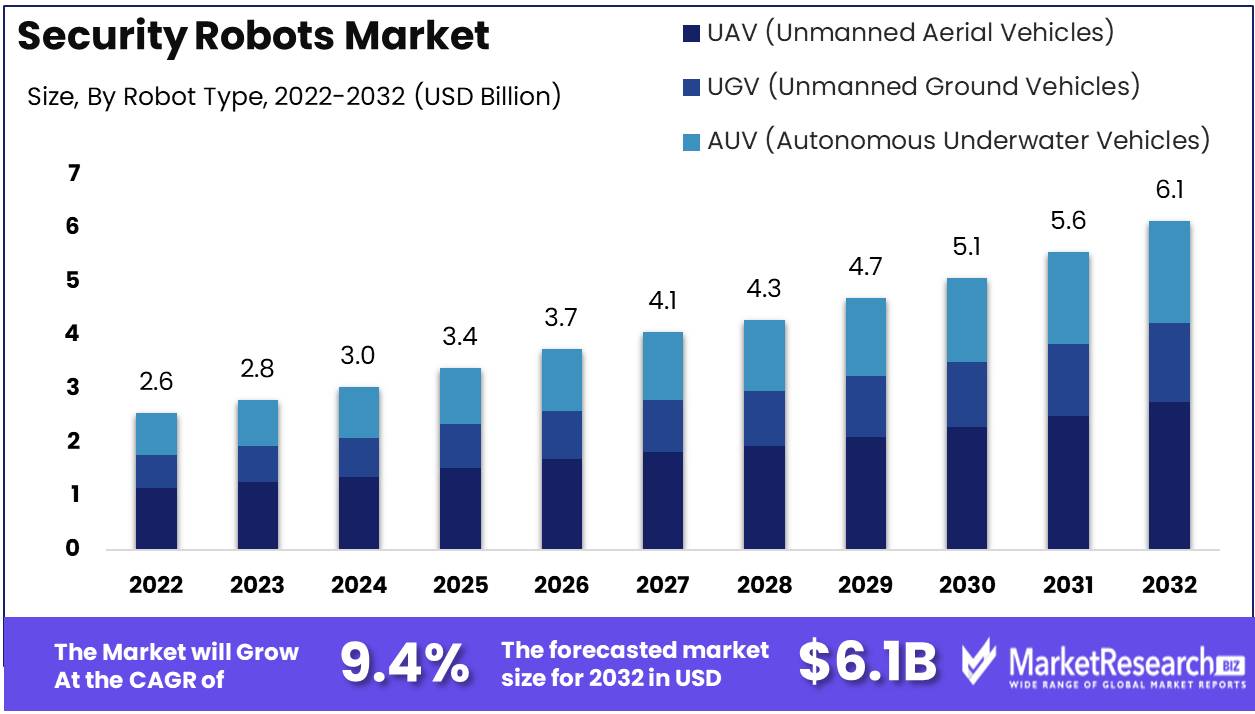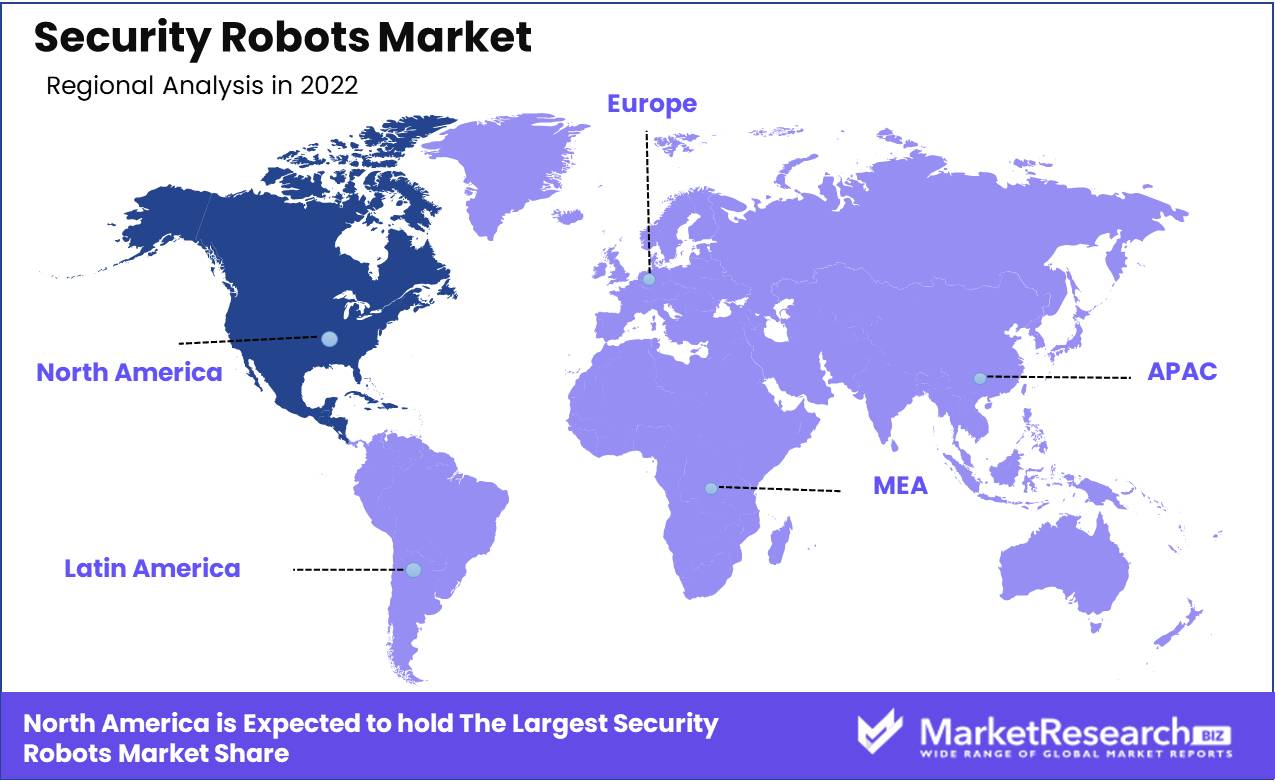
Security Robots Market By Robot Type (UAV, UGV, AUV), By Application (Spying, Explosive Detection, Patrolling, Rescue Operations, Other Applications), By Components (Propulsion System, Frames, Camera Systems, Guidance & Navigation Control System, Propulsion Systems, Other Payloads), By Region And Companies - Industry Segment Outlook, Market Assessment, Competition Scenario, Trends, And Forecast 2023-2032
-
26495
-
Jul 2023
-
174
-
-
This report was compiled by Vishwa Gaul Vishwa is an experienced market research and consulting professional with over 8 years of expertise in the ICT industry, contributing to over 700 reports across telecommunications, software, hardware, and digital solutions. Correspondence Team Lead- ICT Linkedin | Detailed Market research Methodology Our methodology involves a mix of primary research, including interviews with leading mental health experts, and secondary research from reputable medical journals and databases. View Detailed Methodology Page
-
Quick Navigation
Report Overview
Security Robots Market size is expected to be worth around USD 6.1 Bn by 2032 from USD 2.6 Bn in 2022, growing at a CAGR of 9.4% during the forecast period from 2023 to 2032.
The security robot market is swiftly expanding, driven by technological advances and an increasing demand for automated security solutions. These robots are intended to provide a tangible security presence and real-time monitoring capabilities to a variety of areas, including buildings and public spaces. This report will provide an overview of the security robots market, including its definition and objectives, innovations, significant investments, growth and applications, investing industries, market drivers, ethical concerns, and business applications.

One of the greatest benefits of security robots is their ability to supplement human security personnel. While human officers might need pauses and shifts, security robots can perform their duties nonstop and provide continuous surveillance.
In addition, they can perform routine tasks, including monitoring access points and verifying identifications, allowing human administrators to concentrate on more complex security management tasks. Furthermore, security robots are useful in areas with high risks of peril, such as hazardous environments, because they can conduct inspections or monitor unsafe areas where human personnel cannot operate.
In recent years, the security robot market has witnessed a number of noteworthy innovations, including the development of autonomous security robots that operate independently without human intervention. These robots are endowed with artificial intelligence and machine learning, allowing them to acquire knowledge and make decisions in real time. A notable innovation is the incorporation of facial recognition technology, which enables security robots to identify individuals and notify authorities when suspicious individuals are detected.
Driving factors
The Progress That Will Eventually Result in Fully Autonomous Robots
The development of advanced robotics and artificial intelligence technology has made it possible to create security robots that are capable of conducting autonomous patrols, recognizing individuals based on their facial characteristics, and identifying intruders. The demand for these advanced solutions on the market has increased as a result of this.
Increased Worry Regarding Potential Dangers to Security
There is a growing need for advanced surveillance and monitoring solutions due to the increase in terrorist attacks and crime rates. The use of security robots is both an efficient and cost-effective technique to monitor public areas and reduce the likelihood of criminal activity.
Driven Higher by Investment and Funding
To improve their security measures, governments and commercial enterprises are making significant investments in security infrastructure. Additionally playing a big part in the development of the security robots industry has been the investment and financing that has come from both the public and commercial sectors.
Affected by Evolving Technologies
Emerging technologies such as blockchain and 5G networks have the potential to improve the efficacy and dependability of security robots, making them even more useful in the fight against criminal activity.
Emerging Trends
Emerging trends that may have an impact on the security robots market include the use of edge computing and the incorporation of artificial intelligence. Customers are going to demand security solutions that are more intelligent and efficient, as well as ones that are able to analyze enormous volumes of data in real time.
Restraining Factors
Costly initial outlay for deploying security robots
The high initial investment cost necessary to deploy security robots is one of the main restraining factors. Typically, security robots are more costly than conventional security measures such as employing additional security personnel or deploying surveillance cameras. For businesses and organizations contemplating the purchase of security robots, the high cost can be a significant deterrent.
However, it is important to observe that security robots can result in significant long-term cost savings. They can operate 24 hours a day, seven days a week without tiring, requiring vacations, or taking sick days, and they can efficiently cover large areas without additional personnel. Consequently, businesses can reduce their overall security costs, labor expenses, and insurance liabilities.
Security Robots' Limited Capability to Manage Complex Security Situations
The ability of security robots to manage complex security situations is another significant restraining factor. Security robots rely on artificial intelligence (AI) and sensor technologies to detect threats; while they can detect and report threats effectively, they may not be able to make prompt and effective decisions in complex situations.
Despite this, security robots have the ability to provide invaluable assistance in terms of reconnaissance and early warning. They can be used to conduct surveillance, monitor and analyze data in real-time, and provide crisis-related feedback to security personnel. As AI and sensor technology continue to advance, the ability of security robots to manage complex situations will increase.
Type Analysis
The security robots market is evolving swiftly, with the UAV segment dominating the market. In the future years, the UAV segment is anticipated to have the greatest growth rate. The demand for security robotics is increasing due to the worldwide increase in security and safety concerns. The UAV segment is anticipated to be the primary growth driver for the security robots market.
Another significant factor propelling the UAV segment of the security robots market is the economic development of emerging economies. Emerging economies, such as China and India, are experiencing rapid economic growth and making substantial investments in infrastructure development. This trend is driving demand for security technologies, such as UAVs. In addition, technological advancements in developed nations are causing the UAV segment of the security robots market to expand.
Important factors contributing to the expansion of the security robots market include consumer trends and behavior towards the UAV segment. People are becoming more aware of the benefits of security technologies such as UAVs as the need for safety and security increases. To guarantee their safety and privacy, consumers are increasingly willing to invest in security technologies such as unmanned aerial vehicles (UAVs).
Application Analysis
In terms of applications, the Patrolling segment is dominating the security robots market. This segment is essential to the security industry because it provides threat monitoring and protection. Due to the increasing demand for security and safety technologies, the global market for Patrolling is anticipated to develop at a rapid rate.
Economic Growth in Emerging Economies is a major factor propelling the adoption of the Patrolling segment of the security robots market. The increasing demand for security and safety technologies in emerging economies is propelling the development of the security robots market, increasing in demand for Patrolling.
Important factors contributing to the growth of the security robots market include consumer trends and behavior toward the Patrolling segment. People are becoming more aware of the benefits of security technologies that rely on Patrolling as the need for security and safety grows. Consumers are increasingly prepared to invest in these systems to secure their privacy and security.

Components Analysis
In terms of components, the propulsion system segment is dominating the security robots market. This segment's expansion is driven by the rising demand for unmanned systems such as UAVs and UGVs. The global market for propulsion systems for unmanned systems is anticipated to expand at a constant rate as a result of technological advances.
Economic Growth in Emerging Economies is a major factor propelling the propulsion system segment of the security robots market. Increasing demand for security and safety technologies in emerging economies is propelling the growth of the security robot market, increasing in demand for propulsion systems.
Important factors contributing to the expansion of the security robots market include consumer tendencies and propulsion system segment behavior. People are becoming more aware of the benefits of security technologies that rely on propulsion systems as the need for security and safety grows. Consumers are increasingly prepared to invest in these systems to secure their privacy and security.
Key Market Segments
By Robot Type
- UAV (Unmanned Aerial Vehicles)
- UGV (Unmanned Ground Vehicles)
- AUV (Autonomous Underwater Vehicles)
By Application
- Spying
- Explosive Detection
- Patrolling
- Rescue Operations
- Other Applications
By Components
- Propulsion System
- Frames
- Camera Systems
- Guidance & Navigation Control System
- Other Payloads
Growth Opportunity
Ample Fueling Factors
A multitude of factors are fanning the embers of this trend, which is causing the security robots market to experience an unprecedented increase in growth potential. Among these factors are the rising demand for security robots in various industries, the avalanche of technological advancements that are significantly enhancing the capabilities of security robots, the ever-increasing need for surveillance and monitoring in public places, the emergence of novel application areas for security robots, and, last but not least, the rising tide of investments in the research and development of innovative security robot solutions.
Innovative Security Options
As illicit activities and security concerns continue to pose formidable challenges in numerous regions of the world, the demand for innovative security solutions grows. As devices of unrivaled efficiency and sophistication, security robots are quickly becoming the go-to option for organizations, governments, and businesses that require dependable and stringent monitoring and surveillance.
Technological Progress
One of the primary reasons for the precipitous rise of security robots is the immense technological advances that have vastly improved the capabilities and effectiveness of these robots. With advanced sensing, vision, and communication technologies that make them highly adaptable and responsive to various security challenges, security robots can now detect and respond promptly and effectively to potential threats, thereby reducing the risk of security lapses.
Latest Trends
Increasing Knowledge of the Advantages of Robotic Security Systems
Increasing awareness of the benefits of automated security systems is one of the most significant growth drivers for the security robots market. As an increasing number of businesses and organizations recognize the potential of these technologies, demand is exploding. Robotic security systems can be used to monitor and patrol expansive areas, enable quick responses to potential threats, and reduce the need for human security personnel. Additionally, they are highly adaptable and can be tailored to satisfy the specific requirements of various industries and organizations.
Global expansion of the security industry
Increasing concerns about crime, terrorism, and other hazards are fueling a rapid expansion of the security industry. The rise of automated security systems is likely to accelerate this growth. Numerous global regions, including North America, Europe, and Asia-Pacific, are investing substantially in these technologies. The global security market is anticipated to surpass $125 billion by 2026, with robotics and AI technologies playing a significant role in this expansion.
Automation Adoption in Numerous Industries
The increasing adoption of automation across various industries is another factor contributing to the expansion of the security robots market. From manufacturing to logistics and transportation, an increasing number of companies are adopting automated systems to increase efficiency and reduce costs. This trend is driving the demand for robotic security systems that can be integrated into existing automated operations to improve security and streamline operations.
Regional Analysis
The security robots market in North America is anticipated to experience significant development in the future years due to several factors. The increasing adoption of security robots by law enforcement agencies and private security firms is one of the primary drivers. These businesses are deploying security robots to improve their security capabilities and response times to potential security dangers.
The development of artificial intelligence and robotics technologies is another factor fueling the growth of the North American security robot market. These developments have resulted in the creation of more advanced and sophisticated security robots that are capable of conducting complex tasks and adapting to changing environments.
Increasing concerns over public safety and security also contribute to the expansion of the North American security robots market. With the growing threat of terrorism, crime, and other security risks, airports, retail centres, and other high-traffic public spaces must implement more stringent security measures.

Key Regions and Countries
North America
- US
- Canada
- Mexico
Western Europe
- Germany
- France
- The UK
- Spain
- Italy
- Portugal
- Ireland
- Austria
- Switzerland
- Benelux
- Nordic
- Rest of Western Europe
Eastern Europe
- Russia
- Poland
- The Czech Republic
- Greece
- Rest of Eastern Europe
APAC
- China
- Japan
- South Korea
- India
- Australia & New Zealand
- Indonesia
- Malaysia
- Philippines
- Singapore
- Thailand
- Vietnam
- Rest of APAC
Latin America
- Brazil
- Colombia
- Chile
- Argentina
- Costa Rica
- Rest of Latin America
Middle East & Africa
- Algeria
- Egypt
- Israel
- Kuwait
- Nigeria
- Saudi Arabia
- South Africa
- Turkey
- United Arab Emirates
- Rest of MEA
Key Players Analysis
The security robots market is expanding, and key industry players have taken notice. In industries such as education, hospitality, and healthcare, security robots are gaining popularity due to advancements in robotics technology over time.
Knightscope, a California-based startup that designs and manufactures autonomous security robots, is one of the dominant players in this market. Their robots can be found patrolling retail centers, airports, and corporate campuses, providing surveillance and activity monitoring 24 hours a day, seven days a week.
Boston Dynamics, which manufactures the Spot robot, is an additional significant player. Spot, which was originally designed for military use, has discovered a new market in security and surveillance. It is light, nimble, and capable of traversing difficult terrain, making it a popular option for outdoor security applications.
Aethon, a robotics company with a strong concentration on hospital security, offers autonomous mobile robots that can deliver medication, supplies, and refuse while also monitoring hospital security. Catalia Health, another player in the healthcare industry, designs robots for patient monitoring and medication management.
Top Key Players in Security Robots Market
- Lockheed Martin Corporation
- Northrop Grumman Corporation
- Thales SA
- BAE Systems PLC
- Elbit Systems Limited
- Leonardo SPA
- Aerovironment Inc.
- Knight Scope Inc.
- SZ DJI Technology Co. Ltd
- SMP Robotics
- Boston Dynamics Inc.
- FLIR Systems Inc.
- Kongsberg Gruppen
- Qinetiq Group PLC
- RoboTex Inc.
- Recon Robotics Inc.
Recent Development
- In December 2020 A nano bug drone capable of traversing even the most challenging environments was unveiled by BAE Systems and UAVTEK for the security robots market. With 30 units already deployed to the British Army, this innovation has the potential to revolutionize our approach to defense and surveillance.
- In September 2020, they will unveil a revised version of their UUV 12, marking their entrance into the market for medium-sized UUVs. This vehicle with a 12-inch diameter promises enhanced capabilities and opens up an entirely new universe of possibilities for underwater exploration and surveillance.
- In March 2020 UMS SKELDAR's release of the V-150 UAV has caused a stir in the drone market. This remarkable drone is ideal for a variety of applications, including military and civilian missions, due to its VTOL capabilities. With Saab and UMS Aero Group at the forefront, this innovative unmanned aerial vehicle project has been attracting attention and garnering traction.
Report Scope
Report Features Description Market Value (2022) USD 2.6 Bn Forecast Revenue (2032) USD 6.1 Bn CAGR (2023-2032) 9.4% Base Year for Estimation 2022 Historic Period 2016-2022 Forecast Period 2023-2032 Report Coverage Revenue Forecast, Market Dynamics, COVID-19 Impact, Competitive Landscape, Recent Developments Segments Covered By Robot Type (Unmanned Aerial Vehicles, Unmanned Ground Vehicles, Autonomous Underwater Vehicles), By Application (Spying, Explosive Detection, Patrolling, Rescue Operations, Other Applications), By Components (Propulsion System, Frames, Camera Systems, Guidance & Navigation Control System, Propulsion Systems, Other Payloads) Regional Analysis North America – The US, Canada, & Mexico; Western Europe – Germany, France, The UK, Spain, Italy, Portugal, Ireland, Austria, Switzerland, Benelux, Nordic, & Rest of Western Europe; Eastern Europe – Russia, Poland, The Czech Republic, Greece, & Rest of Eastern Europe; APAC – China, Japan, South Korea, India, Australia & New Zealand, Indonesia, Malaysia, Philippines, Singapore, Thailand, Vietnam, & Rest of APAC; Latin America – Brazil, Colombia, Chile, Argentina, Costa Rica, & Rest of Latin America; Middle East & Africa – Algeria, Egypt, Israel, Kuwait, Nigeria, Saudi Arabia, South Africa, Turkey, United Arab Emirates, & Rest of MEA Competitive Landscape Lockheed Martin Corporation, Northrop Grumman Corporation, Thales SA, BAE Systems PLC, Elbit Systems Limited, Leonardo SPA, Aerovironment Inc., Knight Scope Inc., SZ DJI Technology Co. Ltd, SMP Robotics, Boston Dynamics Inc., FLIR Systems Inc., Kongsberg Gruppen, Qinetiq Group PLC, RoboTex Inc., Recon Robotics Inc. Customization Scope Customization for segments, region/country-level will be provided. Moreover, additional customization can be done based on the requirements. Purchase Options We have three licenses to opt for Single User License, Multi-User License (Up to 5 Users), Corporate Use License (Unlimited User and Printable PDF) -
-
- Lockheed Martin Corporation
- Northrop Grumman Corporation
- Thales SA
- BAE Systems PLC
- Elbit Systems Limited
- Leonardo SPA
- Aerovironment Inc.
- Knight Scope Inc.
- SZ DJI Technology Co. Ltd
- SMP Robotics
- Boston Dynamics Inc.
- FLIR Systems Inc.
- Kongsberg Gruppen
- Qinetiq Group PLC
- RoboTex Inc.
- Recon Robotics Inc.
- Other Players




